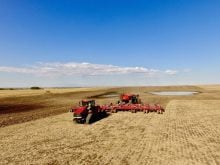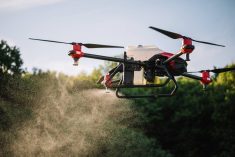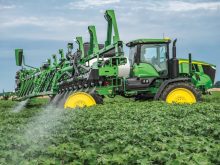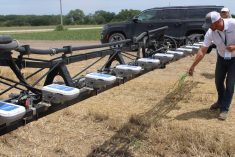As most farmers today agree, the field sprayer is one of the most important and perhaps one of the most used pieces of farm machinery, so with a lot of butt-time in the sprayer seat there is time to ponder ways to get more acres done in a day.
If you are racing against changing weather or trying to optimize a treatment at proper crop staging, it might be tempting simply to open the throttle and drive faster. However, there is a limit to how fast equipment can travel and still do a proper job of product application.
Read Also

Claas brings 1000 Series SP forage harvesters to Canada
In mid-August, Claas unveiled its new line of Jaguar forage harvesters at an event in Visalia, California, deep in the heart of that state’s dairy region.
The better option, say some industry advisors, is to look for ways to reduce downtime between refills and changing chemicals. In fact, it is suggested if you can shave off a few minutes here and there between loads you might be able to travel a bit slower, get better coverage and, in the end, get more acres treated in a day.
- Read more: How to choose the right sprayer nozzle
And our farmer panel members for our December issue of Grainews seem to agree. With everything ranging from small to major changes, they’ve all done something in recent spraying seasons to improve field sprayer efficiency. Here’s what they say helped them accomplish more in a day.
Kris Mayerle
Tisdale, Sask.
In northeast Saskatchewan near Tisdale, Kris Mayerle says they took several steps in recent years to increase capacities to improve field sprayer efficiency.
Farming with two John Deere high-clearance sprayers with 120-foot booms, both sprayers have high-capacity, 1,600-gallon tanks, and the tenders used to carry water for refills also have increased capacity.

“In recent years, we switched from 1,200-gallon tanks on the sprayers to 1,600-gallon tanks,” says Mayerle, who, along with family members, crops about 21,000 acres, which includes pedigreed seed as well as commodity grains and oilseeds.
“Also, in recent years, we increased the capacity of our tenders. There is one for each sprayer and each tender carries about 8,000 gallons, so we fill each sprayer about four times before needing to refill the tenders.”
One other efficiency available with John Deere sprayers included outfitting the sprayers with ExactApply. This individual nozzle control system provides the ability to maintain a consistent droplet size and pattern as you change speeds and adjusts to reduce overlap, skips and drifts over an entire field. Operators have full variable-rate and shut-off functionality at the nozzle level (every 15 to 20 inches), which is an improvement over sprayers equipped with section control.
“With ExactApply, we are able to control the amount of product being applied. We can be more targeted, so that also improves efficiency,” says Mayerle, noting the sprayers probably get more field hours than any other piece of equipment. It varies from year to year, but often the sprayers are used five times during the cropping season — to apply a pre-seed burndown, in-crop herbicides, fungicides as needed, usually a pre-harvest treatment and often a post-harvest weed control treatment.
Dallas Leduc
Glentworth, Sask.
In southwest Saskatchewan, Dallas Leduc says there is always room for improvement, but right now he’s happy with it taking about 20 minutes to reload the field sprayer on his farm.
He says when it comes time to upgrade the field sprayer, he will opt for a 1,600-gallon-capacity tank rather than a 1,200-gallon tank like he has now. And if his ship really does come in, he would probably consider one of those super-efficient chem handling systems that can refill a sprayer in about five minutes. However, at the moment, farm economics can’t justify that $80,000 price tag.
“There is always room to improve efficiency,” says Leduc who crops about 9,400 acres of grains, oilseeds and pulse crops. “But right now my loading time is running between 18 and 22 minutes, and that’s not too bad.”

Leduc runs a Case IH 4440 sprayer with a 1,200-gallon-capacity tank. He is impressed with the AIM Command Flex system, which essentially gives him 36 separate boom sections for more precise control of nozzles and application rates. It can all be adjusted on the go depending on crop, weather and field conditions.
In recent years, he upgraded to a 6,000-gallon aluminum tank that’s used to refill the sprayer — that’s usually more than adequate for a day’s worth of spraying. And the local municipality — Rural Municipality of Waverley — also helped out with efficiency by installing a fast-fill system for bulk loading water in nearby Glentworth. With the new, fast-fill equipment at the bulk water-loading site, he can fill that 6,000-gallon tank in 32 minutes, which is much faster than the old system.
“And one other efficiency I believe makes a big difference is to hire good farm employees,” says Leduc. “If you have good, hired men you can rely on, then everything just seems to run much better. That helps my farm to be more efficient.”
Jake Leguee
Fillmore, Sask.
Jake Leguee, who is part of a family farming operation near Fillmore in southeast Saskatchewan, has introduced a few measures to help improve field sprayer efficiency on their farm.
They use two John Deere sprayers on their 13,000-acre operation during the growing season. The older model has a 1,200-gallon tank, while the newer machine has a 1,600-gallon tank.
“That 400 gallons makes a significant difference,” says Leguee. “It’s not only more capacity, but most products are designed for 40, 80 or 160 acres and the mixing calculations just don’t work out that well on a 1,200-gallon sprayer tank. If I’m trying to figure out a rate for a product on 160 acres, the math works so much better with the 1,600-gallon tank.” He’s thinking it might be worthwhile to upgrade the older sprayer to a 1,600-gallon tank this winter.
Along with the larger chemical tank, Leguee also has outfitted the sprayers with the John Deere ExactApply individual nozzle control system that makes for much more efficient use of crop protection products.

And from a handling perspective, last winter workers in the farm shop built a large two-level shelf or rack unit for the spray trailer that can hold four, 800- to 1,000-litre chemical totes. Two totes sit on the trailer deck and two can be strapped securely onto the rack above.
The spray trailer is 53 feet long with two, 6,000-gallon-capacity water tanks — one at the front of the trailer and one towards the back. The chem handler sits in the middle of the trailer deck between the tanks. There was room next to the forward water tank to install the two-level rack that holds the four chemical totes.
It makes for a very efficient handling system. Leguee says when they are using high-volume products, such as Liberty herbicide, it is more convenient to be able to draw chemical from two or three totes at one time.
“Liberty herbicide just doesn’t flow that well, so if we can draw chemical from three totes at once then we can fill the sprayer tank that much faster,” says Leguee. “It probably speeds things up by about 20 per cent, which is three or four minutes, but when you figure out how many times you fill the sprayer those minutes add up.”
And one other newer efficiency in the past couple of seasons is a computerized guidance system for field sprayers that keeps the wheels travelling in the same tracks. Particularly during in-crop applications, it reduces the amount of trampled crop.
The software developed by Verge Agriculture is called First Pass farm logistics. With the software, Leguee can go online and develop a GPS program that will keep the field sprayers travelling on exactly the same wheel tracks for each spraying operation.
“It is sort of like controlled traffic farming but not quite,” says Leguee. “I just want to minimize the amount of crop damage caused by each sprayer pass and keep those wheels on the same track for each pass. Every time you create a new set of wheel marks in a field, you’re trampling about two per cent of your crop. I want to eliminate that.”
The other benefit, he says, of keeping the sprayer on the same wheel tracks is it reduces the risk of spraying a field and ending up, for example, with a two-foot strip that has been missed.
Greg Newman
Fort Vermilion, Alta.
In the northern Peace River Region of Alberta, Greg Newman says probably the biggest field sprayer efficiency measure he’s made has been to upgrade from a pull-type sprayer to a self-propelled sprayer about four years ago.
Newman, who along with family members farms near Fort Vermilion, says while the pull-type sprayer had a 130-foot-wide boom, the John Deere 4830, with a 100-foot boom, has more capacity and greater flexibility.

“With the old sprayer, we could apply some in-crop products early in the season, but as the crop grew taller, that wasn’t an option because of the low clearance,” he says. “Later in the season, if we wanted to apply a fungicide, for example, we had to hire a custom applicator. Now with a high-clearance sprayer, we can do all of our own spraying.”
One other small change that helped reduce sprayer filling time involved converting the plumbing on the water truck from a two-inch-diameter valve to a three-inch-diameter valve. “Increasing the size of the plumbing reduced our filling time by half,” says Newman.
He pays attention to proper sprayer cleanout between different chemicals used on wheat, canola and pea crops, but he also does his best to schedule chemical use to minimize switching back and forth between different chemistries during the season.
John McKee
Stirling, Alta.
If the shopping trip goes well, John McKee is hoping to have a higher-capacity field sprayer in the fields of his southern Alberta farm in 2022.
McKee, who farms at Stirling, about half an hour southeast of Lethbridge, says the older John Deere 4730 sprayer “still works beautifully and I hate to trade it in.” However, he needs something with a bit more capacity.

McKee is part of the 6,000-acre, family-run, J & C McKee Conservation Farming operation, which also includes his wife, Christine, son, Joseph, along with what he describes are “three athletic daughters” who help out as school permits and, depending on the season, one or two additional workers.
The older sprayer has an 800-gallon tank and a 100-foot boom. It gets the job done as they produce grains and oilseeds on both dryland and irrigated farming systems, but sometimes spraying can be a holdup in spring.
They seed crops with 50-foot and 70-foot air drills, but sometimes one of the drills has to shut down so an operator can switch over and do the spring burndown application ahead of the seeding operation.
The plan is to buy a good used field sprayer with a larger, 1,200-gallon tank and 120-foot boom. “That’s 50 per cent more sprayer capacity with a wider boom, which should allow us to speed up the pre-seed burnoff by about 40 per cent,” says McKee. “If we can spray more acres then, hopefully, the seed drills can keep running longer without any downtime.”
McKee also wants the wider boom to include valves for flushing, which should reduce the time it takes to switch from one chemical to another.

With the older sprayer, it took three full flushes between chemicals and usually took about two hours. “My son, Joseph, is really good about it. He pays attention to proper cleaning,” says McKee. “It takes time, but he says that’s just part of the spraying operation. We’ve never had a wreck (from chemical residue in the sprayer) in all our years of farming, but I know it happens, so we don’t want to cut corners. I want a boom that drains faster and can be easily flushed.”
McKee figures the increased sprayer capacity should also improve the timeliness of spraying operations. “With fungicides, for example, we might only have a three-day window to get it done, so 40 per cent more capacity should help with that too,” he says.
Eric Fridfinnson
Arborg, Man.

From the Interlake Region of central Manitoba, Eric Fridfinnson says he is fortunate to have most of his farmland in close proximity to farm headquarters. With a chemical handler in the yard, he says it is efficient for him to apply a sprayer tank load to about 160 acres and then return to the yard to refill and then go again.
For those fields that are some distance away, he has a 2,000-gallon water truck that’s used to refill the sprayer.
Fridfinnson runs a New Holland 275-horsepower field sprayer with a 120-foot boom outfitted with a 1,600-gallon tank. It is a busy piece of equipment during the year with at least three passes over the farm — spring pre-seed burnoff, at least one in-crop treatment and usually a post-harvest application. Depending on the year, he may also need to apply a fungicide to some crops, and in recent years, he’s also needed to apply insecticide to control grasshoppers.
“One feature of this area that, in some ways, improves field sprayer efficiency is I have good access to custom spraying services,” says Fridfinnson. “It is important to get products applied in a timely manner and if for any reason I feel I am getting behind, I have access to aerial applicators as well as custom ground spraying units, so I can get products applied when they need to be applied.”
















